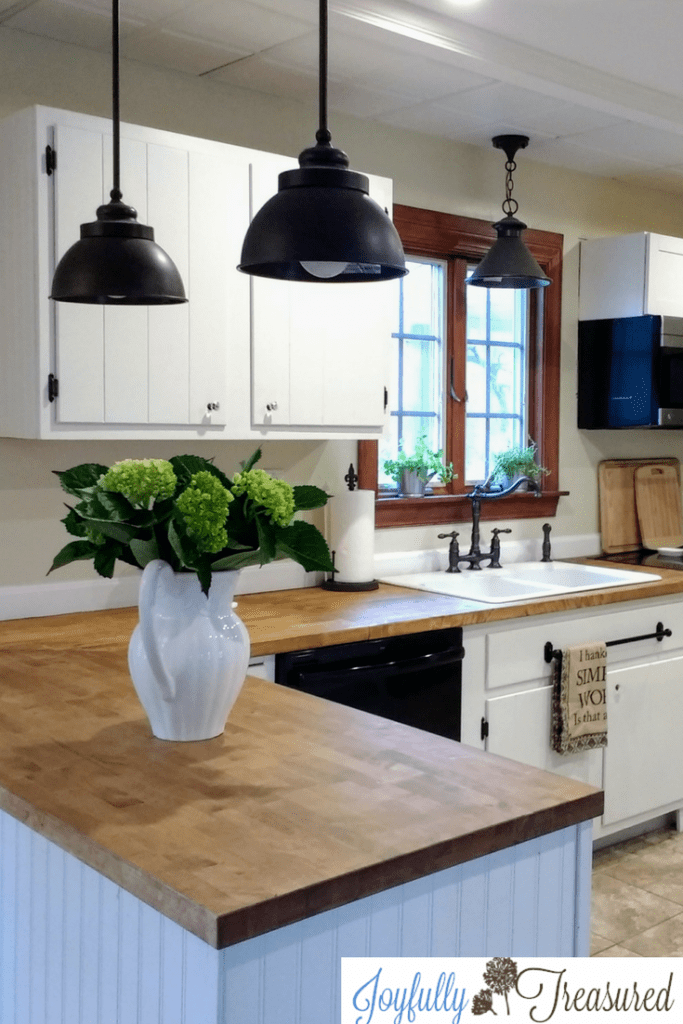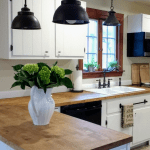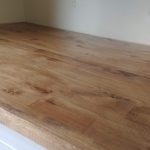When we remodeled our kitchen several years ago, I researched obsessively about the best method for finishing butcher block counters.
We did not want a finish that was a lot of work to maintain, or allow the wood to get stained or scratched easily. I also wanted to somehow stain the butcher block we purchased into a darker warmer shade. Most importantly, we wanted to use a finish that was completely food safe.
In the end, there were two non-toxic finishes that I was considering, tung oil and wood bowl finish. Post may contain affiliate links.
If you’ve read about our kitchen already, you know we adore our dark tung oil butcher block countertops. I saw a photo of what they looked like on birch butcher block with the nice matt finish, and I was sold!

However, for the butcher block on my craft table, I wanted a dark walnut finish. Plus, something that would cure or dry very quickly and need zero maintenance. No tacky oils near my ribbons and supplies, thank you!
I first learned about General Finishes products through their amazing gel stain. When I read about their Wood Bowl finish when exploring options for finishing butcher block, I was really excited to try it out!
I first used it on the island slab on my shipping table. I loved it so much, that I used it again for the butcher block we installed around the sink in our powder room.

Wood bowl finish is a glossy and durable water proof finish. If you happen to have a wooden salad bowl or tongs…you already have an idea of how bowl finish looks!
What we loved:
- bowl finish dries to a non toxic and food safe surface
- creates a very durable, water repelling, glossy finish
- maximum color options: apply the bowl finish on top of any stain color of choice
The Downside:
- It is not recommended that you cut or chop routinely on counter tops sealed with bowl finish. (Many other popular butcher block finishes I learned about, such as Waterlox, are not recommended for chopping.)
So, if you wouldn’t dream of chopping directly on your beautifully finished countertops, this could be a great option!
However, if you might cut on your butcher block counters directly… tung oil or mineral oil would be good options to consider!
Finishing Butcher Block with Wood Bowl Finish
The butcher block worktop is an inexpensive island slab from Lumber Liquidators. Since the wood tone is very pale, I wanted to use a nice dark walnut stain.
Supplies:
Application:
First, I sanded the surface lightly with a hand sander.

I did this mainly because I was using the butcher block several months without sealing it, and there were some marks here and there in the surface. There were also a few planks in the island that had a rough texture.
Once it was nice and smooth, I wiped the surface clean and let dry. Try to sand evenly over the whole surface, as the more you sand, the darker the stain will be.
I can tell the stubborn marks where I over sanded because the stain came out darker! If this was not in my craft room, I would have just used the orbital sander to make it easy to sand uniformly.
Next, I applied a dark walnut stain with a sock.

I applied it lightly with one sock rag, and wiped gently with a fresh one as I moved across the worktop. It only took one light coat to get a nice dark finish!
After the stain cured, I applied the wood bowl finish with a rag.

It is very quick and easy to apply. I simple wiped on a thin coat with a rag, being careful to wipe up any excess. Here is the first coat being applied.

General finishes recommends 24 hours between coats. So I sealed the butcher block with three coats 24-36 hours apart.
They also recommended sanding with a very fine grit (220-320) sanding foam between coats.
The finish felt completely dry when I checked it after 24 hours. General Finishes states the product takes 3o days to fully cure, and to avoid placing any heavy objects on the finish during that time.
The table was used every day during the curing period. I was just careful to treat it gently for the first couple weeks.

I really love how this finish turned out. It was a breeze to apply and requires virtually zero maintenance. I wouldn’t hesitate to use bowl finish again for finishing butcher block.
In fact, I already used it on the butcher block in the powder room! Since it seals so water proof, it doesn’t need to be babied as far as rigorous cleaning.
Next, I am going to use it for the wet bar butcher block in the basement.

I’ve been working away at reorganizing the office. It didn’t quite get finished before our new baby arrived…but it is nearly there!
Happily, the shipping table is finished! It is so functional now, and I enjoy shipping orders much more! I can’t wait to complete the last few projects in the office!





Thank you for sharing your experience with butcher block. I read your post about your kitchen counters too. We’re contemplating using it in our kitchen and researching sealant options. Does the tung oil in the kitchen give it an orange hue. I currently have the orange oak cabinets (that I really don’t like) that will be painted but want to avoid adding a sealant to new countertops that might bring that orange hue back into a renovated kitchen. I’m leaning more towards this Wood Bowl finish just based on how it comes across in the pictures. If you had to do your kitchen again knowing what you know now which application would you choose?
Hi Carolyn!
Thank you so much! I really enjoy both finishes! The tung oil is slightly more matte, and I would say the wood has a slightly orange hue. Not 80’s orange oak, because it has a darker, more rustic coloring that darkens over time. But, I definitely understand where you are coming from with orange oak! The wood bowl finish has a bit easier application, and allows you to control the base color completely, which is a great benefit! You could color match on a scrap piece, and be certain you are getting the tone you want for your kitchen.
Since I chop on our counters sometimes, I really like tung oil. If I was more careful about that, I think I would try the wood bowl finish in our kitchen. I hope that helps! 🙂